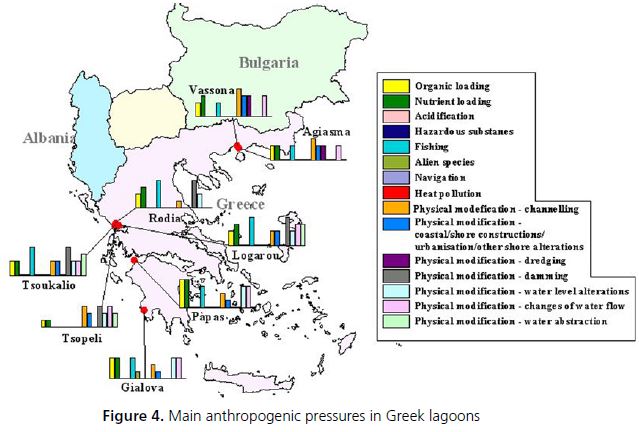5.6 Interactions among aquaculture, capture fisheries and the environment in coastal lagoon management
The main anthropogenic pressures to which coastal lagoons are subjected in Greece are agriculture, animal husbandry, dam constructions, water level alterations and overfishing (Fig. 4). In the lagoons’ catchment area ground waters can also be polluted in terms of total nitrogen, phosphorus and organic pollutants. The above pressures have also substantial impact on the lagoon ecological quality.

Figure 4. Main anthropogenic pressures in Greek lagoons
There was a considerable loss of the wetlands of the coastal lagoons in the last century, due to the increase of artificial and cultivated areas.
Many of the lagoons’ catchments waters can be organically polluted due to anthropogenic stressors such as agriculture, aquaculture, animal husbandry, etc.
Environmental effects of aquaculture and capture fisheries on biodiversity conservation
In some lagoons (e.g. Papas in Peloponnese), overexploitation of the system due to semi intensive aquaculture activities may lead to dystrophic crises and massive fish kills. Moreover, the loss of surrounding wetlands/habitats due to land use changes led to biodiversity loss.
Juveniles/spat collection in the wild for culture and/or restocking purposes
In many lagoon systems, restocking with Mugil cephalus, Sparus aurata and Dicentrarchus labrax fry is carried out, and in some cases can be supported by food additions.
Elements for green accounting and ecological services
Electricity can be found in almost all the areas and along the shores of the lagoons. For the fishing boats, the main source of energy is diesel fuel. After harvesting, fish are usually transferred in containers by trucks with crushed ice to the local markets.
Due to the loss of wetland habitats, there is a decline of water retention, purification capacity and capacity to regulate peak flows during floods, whereas the river damming affected freshwater and sediment input altering the environmental conditions of the lagoons. In some cases a dramatic decline and/or total loss of fish stocks in the lagoon and adjacent marine environment has been recorded. Organic pollution affected water quality leading to biodiversity changes (e.g. replacement of sea-grasses by opportunistic green macroalgae).